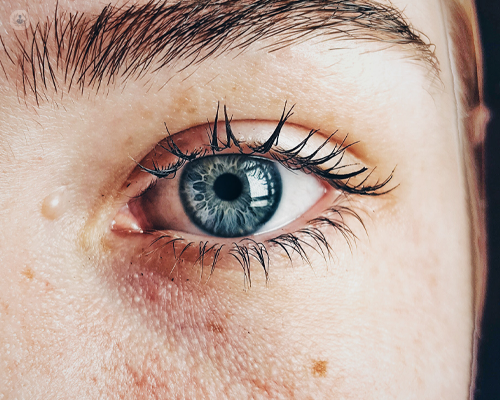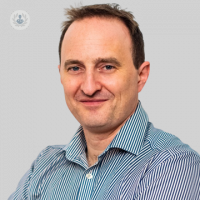Facial reconstruction after skin cancer removal, and Mohs micrographic surgery
Escrito por:The facial skin cancer removal procedure, including the Mohs micrographic surgery technique, naturally leaves a hole, and reconstruction works to fill the space created and recreate structures that may be missing. Without this, it can have a significant impact on patient quality of life, particularly regarding self-esteem around appearance.
Here to tell us all about facial reconstruction and Mohs micrographic surgery in expert and reassuring detail, is leading consultant oral and maxillofacial surgeon Mr Ross Elledge.

What is reconstruction following facial skin cancer removal, and what are its aims?
Many skin cancers are treated predominantly with surgery which involves excising (cutting out) the lesions with predetermined margins down to a sufficient depth to ensure the tumour is completely cleared away. Whilst this cures the cancer in most instances, it naturally leaves a defect (hole) from removal.
Reconstruction is a series of techniques and tricks to "fill the hole" and ensure that patients return to form and function and can make skin cancer a distant memory. This especially important in the head and neck area, where reconstructive techniques aim to recreate structures that may be missing to restore a patient's appearance, potentially having a profound impact on the way they look and feel in their lives going forwards.
What's involved in reconstruction following facial skin cancer removal?
There are many techniques that are used. In the simplest cases, the "hole" created from removal of a facial skin cancer can be closed directly with some sutures in a line (primary closure). This creates a simple linear scar which is placed to blend with the natural skin tension lines of the face and be "hidden".
If defects are larger and/or close to critical structures (e.g. eyelids) then reconstruction can be more complex. This may involve using flaps of skin rotated or transposed into defects from adjacent skin to spread the tension of the closure and maintain the contour of the face and its structures. Sometimes, skin may be needed to be imported from elsewhere such as skin grafts from areas of laxity (skin excess) that we all have, such as the neck or thigh.
Very occasionally, defects created following skin cancer are much larger and require the highest complexity of reconstruction involving transposition of vascularised tissue from around the body (grafts with their own blood supply) and/or prosthetic rehabilitation (e.g. fake ears or noses that are created with a blend of artistic sensitivity and technical proficiency to appear to bend seamlessly with natural structures).
What is Mohs micrographic surgery, and do you need reconstruction after Mohs?
Mohs surgery is a technique whereby skin cancers are removed in stages at a single sitting and analysed with a microscope in real time. This ensures optimal control of the margins to clear the tumour efficiently with the smallest possible defect.
It is labour intensive and time consuming but particularly suited for indistinct tumours (where it is difficult to identify the edges) and/or tumours in critical areas where closer margins are inherently important (e.g. around the eyelids).
This surgery is performed by my colleagues in dermatology and my work is providing the reconstruction to "fill the hole" using the tips and tricks that I know to restore form and function. It can be difficult to predict the size of the eventual defect after clearance, so my aim is always to meet with patients before Mohs to prepare them for every eventuality.
How long does it take for facial reconstruction following skin cancer removal to heal?
This varies according to the complexity of the procedure. Simple excisions with small local flaps will more than likely have sutures removed at one week and by the time the results from the excision are through a few weeks later, patients are well on the way to scars blending and settling down imperceptibly.
Skin grafts and more complex repairs may require a number of dressings appointments with dedicated nurses in the weeks following surgery and timelines may vary for eventual recovery depending upon other conditions (e.g. diabetes), post-operative complications and local wound factors.
Ordinarily I would anticipate that all patients will be happy and settled at 4 to 6 weeks following treatment when they are seen for results and almost always closing the door on what may have been a frightening (but manageable) time in their lives.
Is facial reconstruction following skin cancer removal painful?
No! There are different ways of doing this treatment but in most instances, surgery is performed under local anaesthesia. This involves a few injections at the beginning to enable nerve blocks in the region and ensure that surgery is then completely painless.
I tend to have music on and the most painful thing can be the music choices on my side but I am open to suggestions! I tend to try and keep the conversation flowing during the procedure to enable patients to feel at ease, calm and relaxed throughout the surgery.
Occasionally, for larger defects, we may consider sedation or general anaesthesia, enabling larger scale reconstructions with optimal pain control intra-operatively and post-operatively, to ensure an uneventful recovery.
Does facial reconstruction leave scars, and how are these minimised?
Every incision makes a scar but the artistry is in hiding these and making them as imperceptible as possible. Keeping wounds neat and using fine suture material are small steps that are taken to ensure that patients are happy with the cosmetic outcomes.
Local flap reconstruction aims to minimise forces on delicate structures such as eyelids and hide incisions within tension lines and imperceptible areas around the face.
Finally, optimising post-operative wound care with regular wound reviews and timely management of any complications ensures patients have the best recovery and aesthetics.
If you require top expert facial reconstruction after facial skin cancer removal, arrange a consultation with Mr Elledge via his Top Doctors profile.


